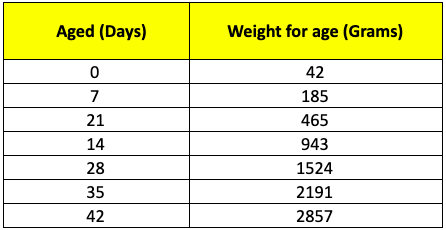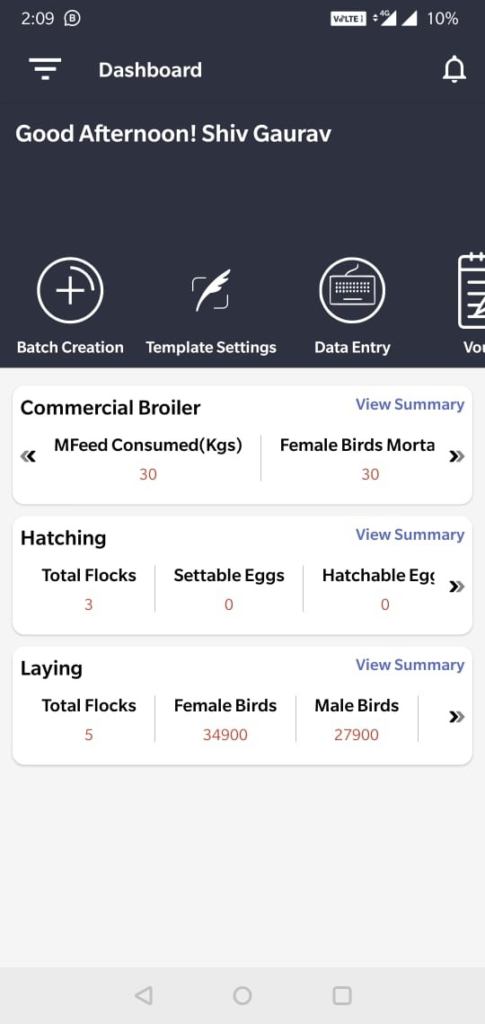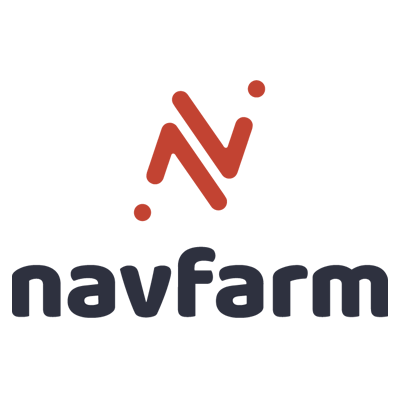Broilers are chickens that are specifically bred and raised for their meat. The goal for any broiler farmer is to successfully raise a day-old chick to a market ready chicken in the shortest amount of time. Within this period the birds will likely meet many challenges that will inhibit their growth and affect their production.
Therefore, broiler production systems require management to have high levels of responsiveness and availability of information. To be a successful broiler farmer at any level, one has to master the day-to-day management tasks of the broiler’s life.
Similarly feed makes up 65-70% of the total cost of production. Its importance to understand good quality, well balanced formulated feed for the best possible production results.
Let’s explore how Navfarm can help in effectively manage your broiler management.
Post-placement Chick Checks
| Weigh some of the chicks to get a starting weight. |
Chick-check 1: 4/6 hours after placement: Test the temperature of the feet of the chicks against your cheek. If the temperature is cold, this implies pre-heating was improper, and the farmer should re-evaluate his pre-heating procedures.
Results of cold floor temperature:
- Poor early feed intake
- Poor growth
- Poor uniformity
Chick-check 2: 24 hours post placement: This check is called a crop check. The reason for this check is to confirm that the chicks found the placement of feed and water.
- By this time a minimum of 95% of the crops should feel soft and pliable, indicating chicks have successfully located feed and water.
- Hard crop – chicks have not found adequate water. Check water supply immediately.
- Swollen and distended crop – chicks have located water but insufficient feed. Check feed supply immediately.
- Daily checks should be made through out the cycle:
- Check if there are cold spots and draughts in the house.
- Check if the ventilation is correct – no build-up of ammonia.
- Check if the drinkers and feeders are at the correct height and if there are enough of them for birds.
- Check for wet bedding or too dry bedding.
- Keep notes of all dead birds removed
| From day 2, Use troughs for feeding so chicks can learn to eat from it. |
Placement of Chicks
- Stocking density should be adapted with temperature changes. In the summer the stocking rate would be lower than in the winter
- It is important that the chicken house should be cleaned and disinfected at least 1.5 Week or 10-12 days before the placement of the new chicks.
- Pre-heat the floor 2 days before chick placement. (Floor temperature 32˚C)
- Feed and water should also be placed the day before to ensure that it would be room temperature and available when the chicks are placed.
- Use paper to cover 50% of brooding area and place feed on the paper to stimulate intake in the first 24 hours.
- Why brooding?
During the first 14 days a chick cannot properly control its own body temperature. This is why it is so important to manage their environmental temperature. This can be improved by good brooding practices. The development of the following should be concentrated
- The skeletal structure.
- The cardiovascular system.
- Appetite and water consumption.
- Health and immune system.
- Minimize stress.
All these improvements will help accelerate the rate of growth of the chicks.
| For the first 10 days, feed should be on the pan feeders or on paper. |
- Lighting program and its advantages
This can be managed with the age, weight or days before slaughter. Also, in parallel exposure with the light and dark measured in hours.
- A period of darkness is a natural requirement for all animals.
- Better feed conversion because of energy conserved during resting.
- Reduce mortality rate and skeletal defects.
- Stimulates the production of melatonin.
- Melatonin is important in the development of the immune system.
| Do not place feed or water directly under the heat source as this may cause the chicks to eat or drink less than they should. |
- Temperature management
Temperature management is one of the most important tasks, especially during the brooding period. Because any stress chicks experience during this period, will affect the growth and development in other phases. The optimal temperatures are as follow:
- Environmental (Air) temperature 32-33˚C
- Floor temperature 32˚C
- Directly underneath brooders 40.5˚C

- Vaccination:
Prevention is by far the most economical and best method of disease control. Prevention is best achieved by the implementation of an effective bio-security program in conjunction with an appropriate vaccination program. Bio-security is a practice designed to prevent the spread of disease into your farm. Facility is maintained in such a way that there is minimal traffic of biological organisms (viruses, bacteria, rodents, etc.) across its borders. It is the most effective and cheapest means of poultry disease control on the farm. Below are a few key points to a successful farm operation:
- Farms should be fenced.
- Limit non-essential visitors to the farm.
- Farm supervisors should visit the youngest flocks at the beginning of the day and working by age to the oldest flock for the last visit in that day.
- Provide wheel dips or spraying at the farm entrance & allow only necessary vehicles on site.
- Absolutely no other poultry should be kept on the same farm as your broiler unit.
- The area around the poultry house should be free from vegetation, debris and unused equipment that could harbour rodents.
- Adequate down-time between flock placements is essential (10 days).
- Dispose of dead birds immediately.
- Footbaths should be placed at every poultry house entrance.
Vaccination is the administration of antigenic material (a vaccine) to stimulate the bird’s immune system, to develop adaptive immunity to a pathogen. That means that it gives the bird’s defence mechanism a “memory” system against that disease. The most common vaccinations given to broilers are against diseases such as:
- New Castle disease
- Infectious Bursal Disease
- Infectious Bronchitis
It is very important to check with your chick supplier what vaccinations you need to do! Some hatcheries do carry out vaccinations at the hatchery.
- Target Weights
It is important to weigh the chicks as they grow. The sample table below shows the target weights:

- Feed Formulation
Broiler diets are formulated to provide the energy and nutrients essential for health and efficient broiler production. The basic nutritional components required by the birds are water, amino acids, energy, vitamins and minerals. Alternatives to ingredients that are scarce and or expensive. With the rising cost of feed and feed ingredients, most farmers and livestock owners like to produce their own feed to save cost. It is therefore very necessary for farmers to have a good knowledge of feed stuff that can be the best alternatives and they are affordable, readily available and accessible.
ENERGY SOURCES
- Maize, Millet and Sorghum can be used interchangeably.
- Maize Offal, wheat Offal, Brewers waste
- Cassava Peels meal. It can be washed, dried and ground or it is washed, grated, dried, then used
- Cassava Flour
- Rice Bran 10% and palm oil 5% is alternative to maize particularly during scarcity
- Farm Operation Recordkeeping

The biggest function of accurate records is for the farmer to utilize the information in future decision making. Accurate record keeping is essential to monitor the performance and profitability of a flock.
Daily records that should be taken:
- Location/Shed Batch Management
- Daily farm entry
- Mortality and culls
- Feed consumption Schedules
- Water consumption Schedules
- Vaccinations Schedules
- Vet Visits Schedules
- Daily temperatures
- Daily humidity
- Number of birds selected (Output)
- Management & overhead charges
- Output/MIS:

- Date of placement – Start Date and End Date
- Daily Farm Record. (Batch/Breed)
- Age of Bird hatched / DOC Weight
- Live weight (daily/weekly/daily gain)
- Medication Schedule (type/batch/amount/date of administration/date of withdrawal)
- Lighting program followed
- Chick delivery (number/date/time/count in boxes/truck temperature and humidity)
- Chick source Traceability
- Batchwise Cumulative Mortality %
- Stock Density

- Batchwise Feed Used (T)
- Average Batchwise Kg per m2
- Average Age of the Bird
- Average Weight of the Bird
- Growth Standard VS Actual
- Batchwise Cumulative Mortality %
- Batchwise KG Produced
- Batchwise PEF
- Batchwise FCR
- Batchwise Chicks Placed
- Batchwise Running Cost (Identify Cost of Bird)
